|
|
Post by thwhtguardian on Mar 3, 2018 22:38:28 GMT -5
Hellboy: King VoldHellboy Vol.4: The Right Hand of Doom, 2000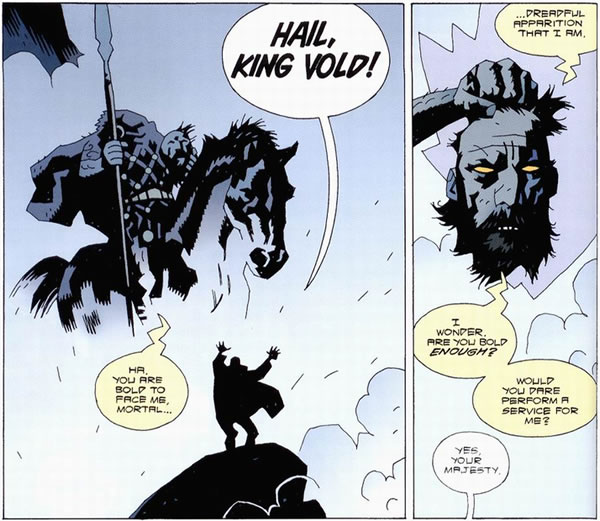 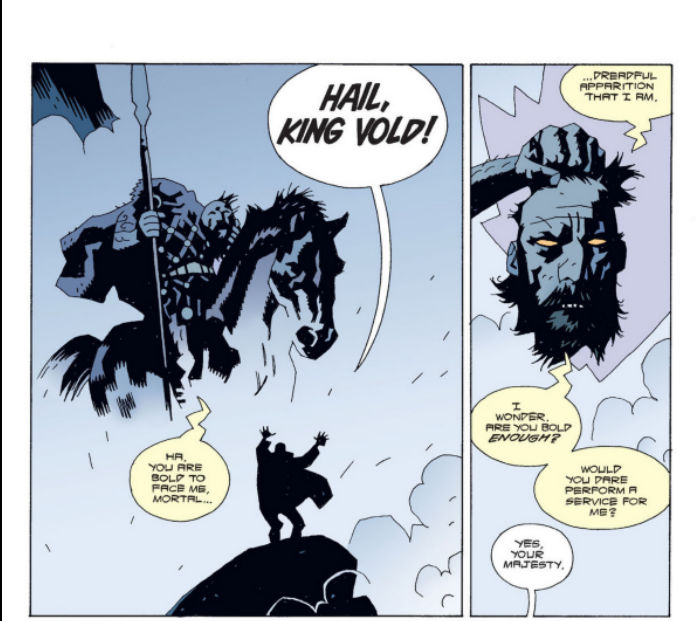 Story and art by Mike Mignola Colored by Dave Stewart Summary: Hellboy is asked by Professor Bruttenholm to assist Prof. Edmond Aickman in Norway in his research into the myth of King Vold. Plot: If you look above, in the italicized section where I normally place the issue number if it isn't a part of the story title, you'll notice it says only Hellboy Vol.4 and you didn't read wrong this story was written especially for the trade making it one of those little treasures that Mike trows in as a reward for sticking with him and oh what a reward it is! King Vold is one of those stories where Mignola uses a series of myths and folktales to build the mood for his story; in this case he gives us an authentic Norwegian feel by including a series of short folklore pieces about trolls in chimmenies, priests accidentally blessing pigs and a church service for the living dead that would make the story wonderful in and of themselves just because of their colorful nature. But as great are those little stories are Mignola didn't stop there; choosing also to tackle the myth of King Vold himself, who is damned to wander the skies after crying out to God that he could keep the skies so long as he could hunt which is a rendition of the wild hunt myth that is common through out Northern Europe, it's a rich myth that Hellboy's response is, "I'm going to have to fight him, huh?" which pretty much sums up the fun of the dicotomy between ancient myths and modern comics that Mike loves to play with. And although Hellboy does end up fighting one of Vold's hounds in typical comic book fashion it ends with a punishment to Professor Aickman that feels like something out of the morality plays from the myths:
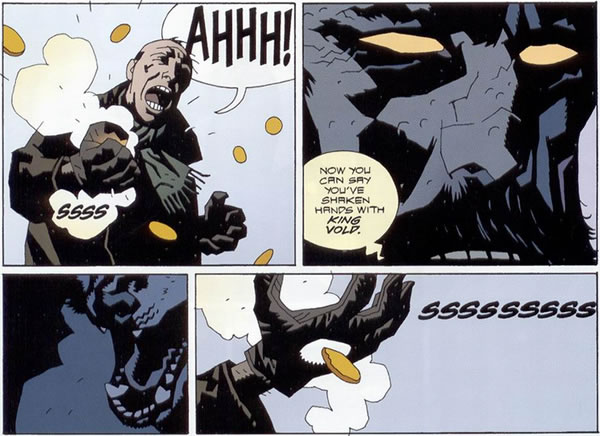 So although Vold and his hound are the aggressor's it's Aikman's greed and exploitation of knowledge that is on display as the villain and it's that cosmic justice that stops that not a punch to the face which is really what makes this story so memorable.
Art: As awesome as the story is the art is just as great, giving us fantastic images like the headless Vold and the coins burning through Aikman's hand seen above but also one of the coolest werewolf transformations I've ever seen...only in reverse as Vold's hound goes from wolf to giant wolf man to viking berserker in a wolf skin cape. It's a great scene that breaks with tradition giving it a memorable look.
Grade:10/10 |
|
|
|
Post by thwhtguardian on Mar 13, 2018 15:35:53 GMT -5
Hellboy in Mexico2010 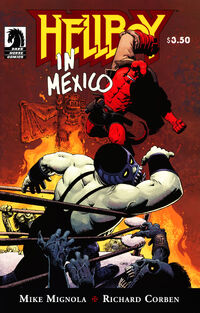 Written by Mike Mignola Art by Richard Corben Year:1956Summary: Hellboy goes to Mexico but it's far from spring break as he faces his bleakest challenge to date. Plot: Back in 2004 Mike Mignola released the following pin up:  It's just Hellboy and a masked luchadore standing on top of a pile of dead vampires. It was simple but glorious and I immediately wanted more but it wasn't until 2010 that Mignola would grant that wish with a series of adventures set in Mexico during his 6 month drunken blur. Mignola would go on to to a total of six stories set during this period, and they are all among my favorite stories, but this first one is something special. Sure, it has Hellboy punching monsters, Luchadores slaying vampires, humor and a killer ending with Hellboy in a demonic version of Wrestlemania(all of which would make for a fantastic comic) but more than that the story has a great back bone about friendship and the earth shattering anguish that comes with losing that friend too early. Hellboy has been given serious friendships in the past, and he's experienced loss before too but it felt real here.
Art: Mignola has collaborated with numerous writers and artists over the years but by far my favorite has been Richard Corben. With these collaborations I often find myself in either one of the two following camps: either the art feels too much like Mignola's and I wonder why have another artist at all, or the look is so wildly different that it doesn't feel like a part of Hellboy's world, but with Corben his look is indeed wildly different than Mignola's but the stories he's worked on still feel like they fit in with the tone of the universe Mignola has created. Though not as clean or moody as Mike's line work Corben's oddly misshapen characters and psychedelic back grounds still evoke that same Universal Horror feeling that has always made me love Mignola's work on Hellboy.
Grade:10/10 |
|
|
|
Post by thwhtguardian on Mar 25, 2018 16:15:54 GMT -5
Hellboy: House of the Living Dead2011 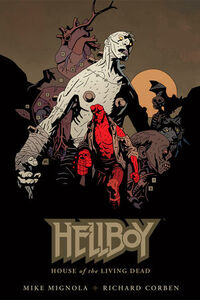 Written by Mike Mignola Art by Richard Corben Year:1956 Summary:Devastated over the loss of his luchador comrade, Hellboy lingers in Mexican bars until he's forced to grapple with the Frankenstein monster with much more than a belt at Wrestlemania at stake.
Plot: It seems like Mike Mignola had one plan for Hellboy: House of the Living Dead: pack the graphic novel with as many classic horror monsters as possible then have Hellboy beat them to a bloody pulp. Congratulations, mission accomplished! In this first experiment at a stand alone graphic novel Hellboy carves his way through a horde of ghosts, ghouls, vampires, a reluctant werewolf and yes the Frankenstein monster but it would be unfair to paint Hellboy: House of the Living Dead as just a wall to wall action fest, as despite the metric tons of action the book does contain Mignola in fact does manage to expose us to an almost forgotten chapter of Hellboy’s life that reminds us of how human he really is.
Through out all the many colorful stories that Mignola has crafted around Hellboy there have been two major forces pulling on the titular hero: the call of his demonic heritage and the struggle of trying to live a simple mortal life despite being a creature with a powerful destiny and here we see the beginnings of how these competing forces effect our young hero as he leaves the safety of his adolescence. Reeling from the death of a close friend and plunged into darkness, Hellboy battles as many inner demons as he does physical ones before learning that he can't hold himself responsible for the deaths around him as that is simple the fragile nature of human life. In typical Mignola fashion however it's not all tragedy as the book ends on a darkly humorous note: after all is said and done the Frankenstein monster lumbers into the bar Hellboy is recovering you start to think their previous battle is about to resume when in a twist Hellboy simply buys the creature a beer and the two sit together at the bar.
Art: Corben’s sense of atmosphere is absolutely stunning through out this whole book. From the ancient stone castle to the mist consumed graveyard, Corben envelopes us in each and every location giving the story a true sense of place that really grounds us solidly in the world of Hellboy. Of course a Hellboy book wouldn’t be a Hellboy book if it were not filled with monsters and Corben makes sure it happens. His take on monsters that have been portrayed literally thousands of times is fresh and left me thinking about their hideous design long after I finished the book. In particular I was floored by the elongated features of the Frankenstein monster; it was a truly unique look and yet it was immediately recognizable as that most famouse of creatures which really speaks to Corben’s ability to make the familiar bizarre and frightening once again.
Grade:10/10 |
|
|
|
Post by thwhtguardian on Mar 31, 2018 20:57:29 GMT -5
Hellboy Versus the Aztec MummyDark Horse Presents #7, 2011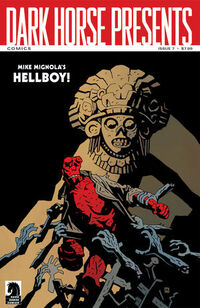 Story and Art by Mike Mignola Year:1956 Summary: In a drunken stupor Hellboy encounters what he thinks is a simple mummy, but learns that it is much more. Plot: In this short piece Mike Mignola gives us a story that hearkens back to his earliest stories with a fun punch em up tale of Hellboy quickly getting out of his depth. This short doesn't have any of the depth of emotion that the previous Mexico stories had but it lives up to the amazingly fun Universal monster movie title that Mignola lovingly bestowed upon this. Although largely focused on a simple plot of Hellboy encountering a shape changing mummy it ends with a connection to Hellboy's ultimate fate that is delivered in one of Mignola's favorite narrative crutches; talking heads. While it provided an interesting bit of Aztec mythology I thought the more ambiguous ending that Mignola gave us a page before the Mexican farmer told his tale of the Aztec gods was much stronger: 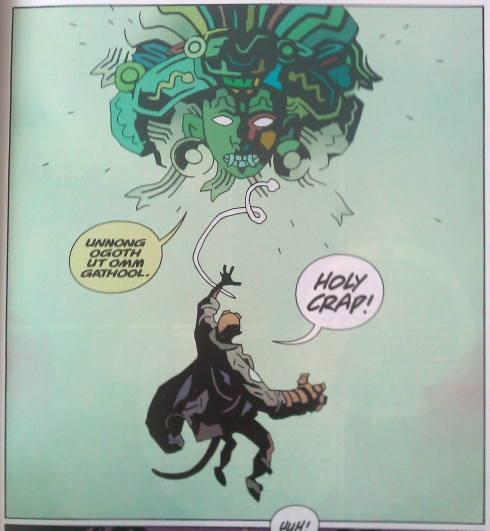 Hellboy punches the mummy, and then a glowing god appears out of nowhere, speaks the demon language and then eaves Hellboy alone in the dark pondering what the heck just happened just like the rest of us. That's showing rather than telling, and ultimately it gives you the same ending with out spoon feeding us; the ugdru hem were the old gods making Helboy's fate a battle between the future and the past. In my head that's how this story ends. It's a fun story, but flawed.
Art: There's not a whole lot to more to say about Mignola's art that I haven't already said; but just look at that image above. Soak it in. Just bask in the intricate details of that headdress. It's simply beautiful. I don't due tattoos but I think if I did I'd want that head on me. It's seriously one of the single best images I think Mignola has done.
Grade:7/10
|
|
|
|
Post by hasan459 on Aug 9, 2018 5:08:19 GMT -5
i have didnot read hellboy but i have watched movie and i love it
|
|
|
|
Post by thwhtguardian on Aug 13, 2018 15:51:18 GMT -5
i have didnot read hellboy but i have watched movie and i love it The movies were pretty fun, they may not adept the plots very faithfully but the energy is right. |
|
|
|
Post by hasan459 on Aug 14, 2018 4:56:43 GMT -5
i have didnot read hellboy but i have watched movie and i love it The movies were pretty fun, they may not adept the plots very faithfully but the energy is right. and i dont like hellboy face, hahaha. |
|
|
|
Post by thwhtguardian on Sept 1, 2018 9:05:54 GMT -5
Hellboy: The Coffin ManHellboy 20th Anniversary Sampler and DHP #2002014-15 Written by Mike Mignola Art by Fábio Moon and Gabriel Bá Summary: Hellboy's trip to Mexico comes to it's end as Big Red battles a Warlock with a penchant for body snatching.
Plot: This latest sojourn into Mexico was delivered by Mignola in two parts...and curiously they were published almost a year a part. I don't know if the gap was planned or due to the way the art was structured(more on that later) but it strangely worked out; it's really one of the few stories that I think worked better serialized than collected. In the first part we're introduced to the Coffin Man, who steals bodies for occult purposes and Hellboy goes out to shut him down...only to be defeated. It was a shock, Hellboy was beaten...and that was it, no further conclusion or explanation. We've never seen that before or since(until the sequel) it was unique and trilling, and so when a sequel was released it was an instant moment of euphoria," Oh yeah, the rematch!"...and you just don't get that surge when you read both back to back. Don't get me wrong, it's still a fun beat em' up, action story with a fun villain who for once doesn't even care about Hellboy or world domination, but the wait between chapters really heightened the experience. Aside from the great movie serial feel to the adventure, my favorite part was really the ending in which after being defeated and turned into a monkey Hellboy awakens the next day, finds that his bottle of booze is sadly empty and then in a greater shock discovers that after his whilwind bender...
he is missing his pants.
We've all been there right?
Well maybe not getting turned into a monkey after battling a sorcerer(though my head has sometimes felt like that maybe, might have happened), but you get the gist of it, and it's a very human moment and those are he times when Hellboy is truly at it's finest in terms of story telling. Sure, he's a big red demon who fights monsters...but somehow he feels real and grounded through it all which is some real magic.
Art: Adding to the unique feel of this story is the art by Moon and Bá, in the past they collaborated artistically in their sojourns into the world of Hellboy but here they each got their own part with Moon doing all of the first issue and Bá the second. Though they both use an angular cartoony style Moon’s are less sharp, less extreme and Bá draws in a more stylized fashion, with a more twisted, crooked version of the Coffin Man. In the Bá story, the night is blacker, as opposed to the deep navy of the Moon story. The differences are so subtle but very noticeable, and in their past collaborations it was fun to try and spot where one ended and the other began, but here we got to see them in isolation which really allows you to appreciate their individual work. As I said earlier, I don't know if the gap was due to something with Ba which interfered with him completing his half or if it was planned by Mignola but either way I think it made for a better read.
Grade:8/10 |
|
|
|
Post by thwhtguardian on Sept 1, 2018 12:10:26 GMT -5
Hellboy: The Crooked ManThe Crooked Man #1-32008   Written by Mike Mignola Art by Richard Corben Year:1958 Summary: Hellboy finds himself in the Appalachian Mountains of Virginia and, as usual, his travels have landed him in the middle of some supernatural trouble.
Plot: When I first saw in the opening panel that this story was set in the Appalachians, I figured I ought to prepare myself for weird, in-bred, hillbilly characters as that's what we tend to see when that neck of the woods appears, but I shouldn't have been worried as Mignola has a much steadier hand. Rather than caricatures Mignola approached the characters in the Crooked with sensitivity and realism; there’s honor and faith to be found in the new cast introduced here. Mignola touches upon these people of the Appalachians as part of a culture, one that’s unlike our own, but something unique and alive all the same. The magic is dark and weird, unlike any we've seen in Hellboy stories past , full of hexes and witchballs which give it a distinct and authentic Southern feel. That small, rural setting extends to the scope of the story as well as instead of some big, world altering horror we see Hellboy pitted against an evil miser who seems content only to lord over a small town but that doesn't mean there isn't a feeling of real treat or that the personal stakes have no meaning; in fact the opposite is true as the smaller stakes make it more personal and more real which really contrasts nicely with the surrounding supernatural world.
Art: Richard Corben and Mignola have collaborated several times but this is by far my favorite. On it's surface these two artists wouldn't seem to be a good fit; Mignola’s style conveys horror by emphasizing what the reader doesn’t see. The monsters hide in shadows, and the audience is left to wonder what terror is to be found at the end of a tentacle while on the other hand Corben's art sets out to scare the readers in the opposite way with detailed line work capturing every grotesque feature of the creatures of the night....but strangely it's a match made in heaven as Corben's in your face style opens up an entirely different world of possibilities for the world of Hellboy.
Grade:10/10 |
|
|
|
Post by thwhtguardian on Sept 3, 2018 18:20:48 GMT -5
Hellboy: The PenanggalanWizard Magazine #148, 2004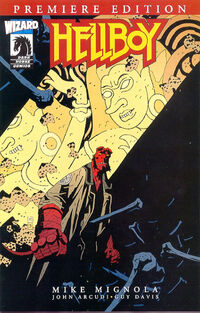 Written and Illustrated by Mike Mignola Year: 1958Summary: When Doctor Hurwood of the BPRD goes missing in India, Hellboy sets out to find out where he went only to encounter a strange vampiric creature. Plot: Growing up my favorite things to read were myths and folklore, and the stranger the better. to that end some of my most prized possessions were a series of "guides" on monsters by Bernhardt Hurwood, but my favorite among his works was Passport to the Supernatural which was a collection of myths he had gathered from around the world as a merchant marine...and it seems like I wasn't the only fan of that book as not only is the strange vampiric floating head trailing it's intestines under it's head very unique but Mignola also named the doctor that Hellboy is searching for after Hurwood which if he were alive would have undoubtedly tickled him. This kind of short little one shot is truly my favorite way to experience Hellboy; sure the epics are fun but these short tales focused on obscure legends are always amazing. Art: Mignola has drawn some cool monsters in his time but this odd variation on the vampire just might be one of my favorites. Even though the design of the creature with it's organs dripping below it's head isn't directly from the twisted mind of Mignola the reveal was just really well done: 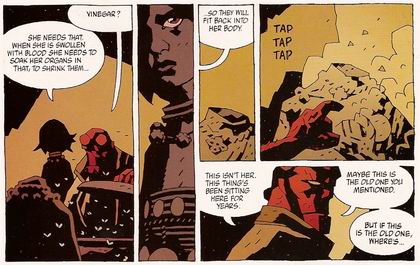 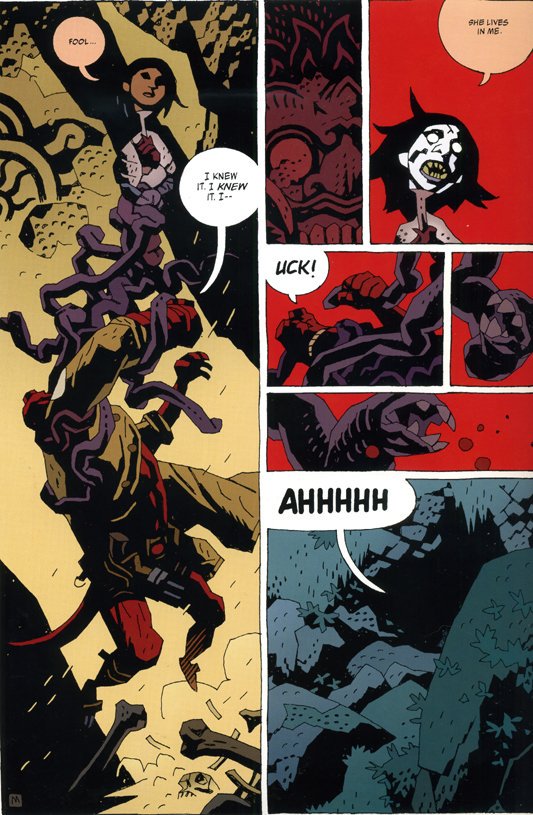 Like a good classic monster movie the reveal has a fantastic twist that really paid off on the tension created by the guide who knew a little too much.
Grade: 10/10 |
|
|
|
Post by thwhtguardian on Nov 19, 2018 11:54:49 GMT -5
Hellboy: The Corpse 1995, Capital City Advance Comics #75-82 Story and Art by Mike Mignola Colored by Matthew Hollingsworth 1959 Summary: Hellboy travels to Ireland to unravel a mystery around a missing child and the Kingdom of Fairy.
Plot: Mike Mignola's The Corpse is probably my favorite comic book of all time. It's a perfect book. I could, literally end this review right there...but I'll continue on and extol the virtues of the book.
Originally published in two page installments in Capital City's Advance Comics Guide in 1995, The Corpse is a fantastic introduction to Hellboy and his world; it's action packed and full of a moody atmosphere that's spooky without being gory, built on the foundation of half-remembered folktales, beautifully designed monsters...and it's crafted in a way that's accessible to all readers and it's brevity is a master class in pacing. To be honest, I think it's that latter point that makes me love this book so much; don't get me wrong I love the stories detailing Hellboy's world ending destiny but I truly feel the short stories showcase Mignola's skills as a story teller. The way he blends folktales, fairytales, myths and blue collar action is a contrast that heightens both elements into something greater than both halves and creates a world that is all the more interesting. Those myths and legends are excellent because they always hint as a world that exists just outside of what you can see, a hidden world that's just beyond our understanding, with rules that have a logic all of their own, that occasionally slips through into the lives of regular people who just happen to brush up against something older...and then Hellboy shows up and although he's a supernatural creature himself he bends all those other worldly elements back on themselves with his "It's just my day job" mantra. That's the whole gimmick of Hellboy, especially in the early stories and the shorts that come between them. It's this idea that he's not just a seven foot tall bright red demon who shows up to bump back against the things that go bump in the night... but that for him, it's routine. It's a hassle. It's a mystical world full of immortal, incomprehensible forces that will ultimately control his destiny, but more often than not, it's just something he has to deal with today. That compare and contrast is dark, but ultimately creates a wonderful element of comedy and that shine's brightest in this story with Hellboy's increasingly frustrated conversations with the corpse as he carries him around Ireland against the backdrop of fiery ghosts, man eating mermaids and giant pig monsters.
Art: I could write thousands upon thousands of words about Mike Mignola's art and how magnificent it is at conveying the plot which is especially stunning in a story told in two-page installments, based on a folktale that was chosen specifically because it could be broken into a handful of short scenes that fit the minuscule page count...but in this case I think the heavy praise should go to the colorist Matthew Hollingsworth. Although Mignola's simple line work and use of shadow do much to create the world and creates a mood rife with tension Hollingsworth's pallet does a tremendous job at catching up the uniformed reader just who the hero is in the story with out needing any of the back story of Anung Un Ramas or Rasputin with just a simple use of color. In a story full of shadows, taking place entirely at night, and everything around him is dark, grey, or the washed-out brown Hellboy himself is always bright, primary, crayola red. The contrast makes him the focus of every panel he's in, and since we're accustomed to the hero being the center of attention in a story the focus drawn on Hellboy because of that use of color makes us immediately see him as the hero with out any dialogue needing to tell us this. It's soimple, instantaneous and beautiful.
Grade:10/10 |
|
|
|
Post by Deleted on Dec 6, 2018 23:06:38 GMT -5
Not sure if you've seen this, but Dark Horse has posted this extensive timeline of the Mignolaverse...  you can find it here or on the DH FB page. -M |
|
|
|
Post by thwhtguardian on Dec 23, 2018 17:32:01 GMT -5
Hellboy and the BPRD: 1956 #1
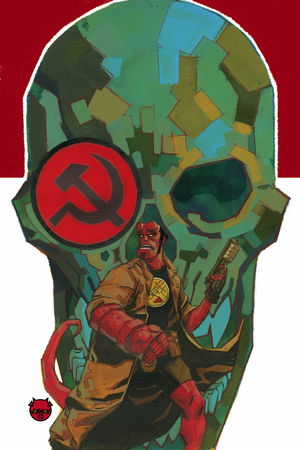
Written by Mike Mignola and Chris Roberson Art by Mike Norton, Michael Avon Oeming and Yishan Lee Summary: As the Cold War expands into the supernatural the chronically underfunded BPRD suddenly finds itself in demand and it put through a rapid growth to cover the interests of the United States. Plot: Hellboy and the BPRD has been a little uneven under the partnership of Roberson and Mignola and although I really liked the focus on the Soviet Supernatural Menace that has been building through out the various Hellboy books over the years I wasn't sure how I felt about a fractured plot line with very distinct and separate stories taking place in the same book. Balancing the prequel to Hellboy's sojourn into Mexico, the Professor's investigation into Varvara and Susan's growing telepathy is a tall order...but at least in this issue it came out really well, although separate(even down to them each having their own artist) neither piece felt more important than the others, they all got equal time and although tackling different topics they didn't clash as they felt linked by the idea the BPRD was going through serious growing pains and that this format was illustrating that.
My favorite part though? Mac, Hellboy's dog, died and that there was no one with time to grieve with Hellboy was incredibly poignant... and done so succinctly. It was perfect story telling.
Art: All the art was fantastic, but Omeming was head and shoulders above the rest in my book. I just love how he brought a quiet menace to such an angelic visage as Varvara. There was a very real sense of other worldly presence to her that just gave her weight in every panel she was in, and that feeling coupled with her child like appearance was just plain amazing. Grade:10/10 |
|
|
|
Post by thwhtguardian on Dec 23, 2018 17:34:56 GMT -5
Happy New Year, Ava Galluci  1957 Written by Mike Mignola Art by Ben Stenbeck Every new year at Wakefield Manor the decedents of Ser William Wakefield(who was killed under suspicion of witchcraft in 1662) hold a seance to try and contact their long dead retaliative. Usually just a bit of a bore, they decide to invite Hellboy and medium of ill repute to liven things up but end up with more than they bargained for. This short but sweet cautionary tale of leaving well enough alone was like the adventures of Hellboy of old. He shows up, encounters a creature unexpectedly, shouts boom as he punches it with his mighty stone fist, and then walks calmly away as the creature ultimately takes it's toll on the person who summoned it before vanishing into the night. The set up is thin and laid out quickly, that action is bright and fun and the just desserts at the end have a great golden age feel. There's no grand myth making here or years of story needed to understand what's going on, just a big red guy punching a zombie and while Hellboy does work fantastically well as a long form story, the short tales are just as rewarding in their brevity. Grade:10/10 |
|
|
|
Post by brianf on Jan 7, 2019 5:00:44 GMT -5
Whats yer thoughts on the Hellboy Omnibus's?
I hear they're missing stories - what do you think is the best HB collections?
|
|






















